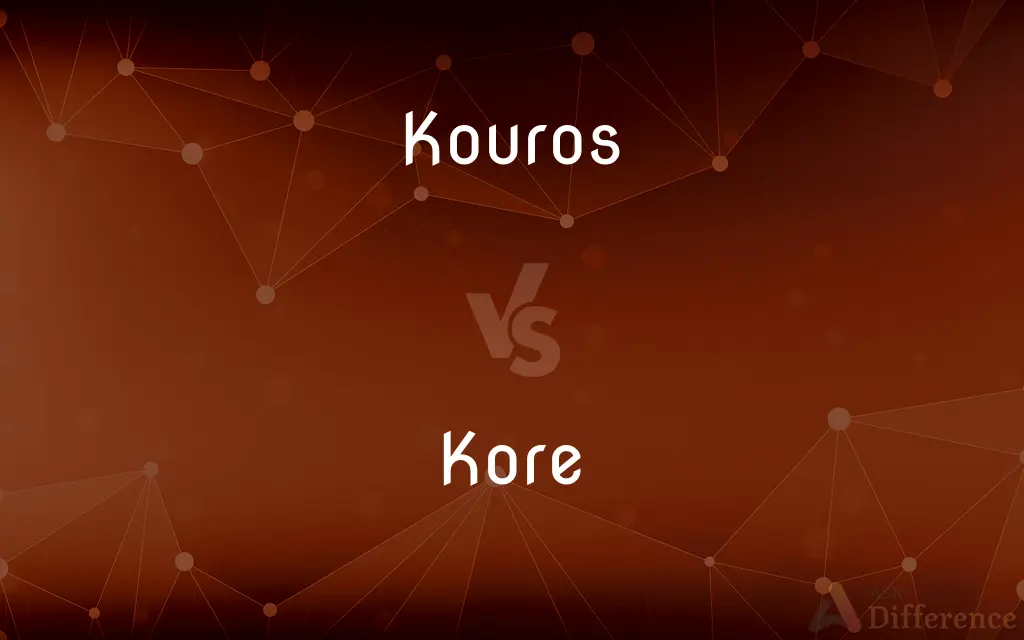Kouros vs. Kore — What's the Difference?
Edited by Tayyaba Rehman — By Maham Liaqat — Updated on May 3, 2024
Kouros refers to freestanding ancient Greek sculptures representing nude male youths, whereas Kore depicts clothed female figures.

Difference Between Kouros and Kore
Table of Contents
ADVERTISEMENT
Key Differences
Kouros sculptures, characterized by their nude, idealized forms, represent the concept of youth and strength in ancient Greek art. On the other hand, Kore statues are distinguished by their depiction of young women, always clothed, symbolizing modesty and the role of women in ancient Greek society.
The pose of a Kouros is typically rigid, standing with one foot forward and arms at the sides, mimicking Egyptian statues, showcasing the Greeks' early artistic influences. Conversely, Kore statues often exhibit a more relaxed stance, though still primarily upright, with details in clothing and ornamentation highlighting femininity and decorum.
Both Kouroi (plural of Kouros) and Korai (plural of Kore) were primarily carved from marble and were brightly painted, though the paint has mostly worn off through time. The approach to details varies; Kouroi focus on muscular anatomy and symmetry, while Korai emphasize intricate garment patterns and hair styles.
In cultural significance, Kouros figures were often used as grave markers or as offerings in sanctuaries, reflecting the values of physical perfection and heroism. Kore statues, however, were typically dedicated to goddesses in sanctuaries and occasionally served as grave markers for women, embodying ideals of beauty and piety.
Interpretations of these sculptures have evolved, with modern archaeology viewing Kouroi as embodiments of the ideal male youth in Greek culture, and Korai representing protected, revered femininity, indicating societal structures and gender norms of the time.
ADVERTISEMENT
Comparison Chart
Depiction
Nude male youths
Clothed female figures
Symbolism
Strength, youth, heroism
Modesty, femininity, piety
Typical Pose
One foot forward, arms at sides, rigid
Upright, relaxed, detailed garments
Material and Style
Marble, symmetrical, muscular detail
Marble, elaborate garments and hair styles
Cultural Use
Grave markers, sanctuary offerings
Sanctuary dedications, grave markers for women
Compare with Definitions
Kouros
An archaic Greek statue of a standing nude male.
The museum’s Kouros is dated back to the 6th century BCE, showcasing early Greek sculpture.
Kore
An archaic Greek statue of a standing clothed female.
The Kore, adorned in draped garments, stands as a testament to women’s roles in ancient society.
Kouros
Marble sculptures that were part of the development from the influence of Egyptian to more naturalistic Greek styles.
This Kouros illustrates the transition in Greek art from rigid forms to more naturalistic representations.
Kore
A symbol of protected and revered femininity in ancient Greece, contrasting with the more exposed forms of male statues.
Unlike the nude Kouroi, the Kore’s attire signifies modesty and piety within the culture.
Kouros
A freestanding sculpture representing a young man, often used as a grave marker in ancient Greece.
Visitors admired the Kouros, remarking on its detailed anatomy and lifelike size.
Kore
A depiction of femininity and decorum, often found in Greek temples and sanctuaries.
The intricately detailed garments on the Kore reflect the high craftsmanship of the time.
Kouros
A sculptural genre from the Archaic period of Greece, characterized by idealized masculinity.
The exhibit features several examples of Kouros, each highlighting different artistic techniques.
Kore
A freestanding sculpture representing a young woman, used in religious and funerary contexts.
This Kore was dedicated to the goddess Athena, indicating her role in religious worship.
Kouros
A symbol of youth and athletic strength in Greek art, typically presented in a frontal, rigid pose.
The Kouros at the temple entrance represents the ideal male form of the era.
Kore
A sculptural form showcasing detailed attire, emphasizing the societal expectations of women.
Each fold in the Kore’s chiton is carved to perfection, highlighting the artist’s skill.
Kouros
A kouros (Ancient Greek: κοῦρος, pronounced [kûːros], plural kouroi) is the modern term given to free-standing ancient Greek sculptures that first appear in the Archaic period in Greece and represent nude male youths. In Ancient Greek kouros means "youth, boy, especially of noble rank".
Kore
A sculpture representing a standing young woman clothed in long robes, especially one produced in Greece before the fifth century BC.
Kouros
A sculpture representing a standing nude young man, especially one produced in Greece before the fifth century BC.
Kore
An Ancient Greek statue of a woman, portrayed standing, usually clothed, painted in bright colours and having an elaborate hairstyle.
Kouros
A sculpture of a naked youth in Ancient Greece, the male equivalent of a kore.
Kore
(Greek mythology) daughter of Zeus and Demeter; made queen of the underworld by Pluto in ancient mythology; identified with Roman Proserpina
Common Curiosities
Why is the Kouros nude while the Kore is clothed?
The nudity of the Kouros reflects Greek ideals of male beauty and heroism, whereas the clothed Kore reflects societal expectations of female modesty and decorum.
What materials were used to make Kouros and Kore statues?
Both types of statues were primarily carved from marble and originally painted.
Are there differences in posture between Kouros and Kore sculptures?
Yes, Kouros sculptures typically have a more rigid, forward-stepping pose, while Kore statues are more upright with detailed clothing.
What does the attire of a Kore tell us?
The attire of a Kore is often elaborate, indicating high status and the cultural importance of clothing and appearance for women in ancient Greece.
What is a Kouros?
A Kouros is an ancient Greek statue representing an idealized nude male youth.
What does a Kore represent?
A Kore represents a clothed young woman and embodies values of modesty and femininity in ancient Greek culture.
What is the significance of the paint on these statues?
The paint, which has largely worn off over the centuries, added lifelike qualities and detailed embellishments to the statues, enhancing their realism and symbolic meanings.
How were Kouros and Kore sculptures used?
Kouros sculptures were often used as grave markers or sanctuary offerings, while Kore statues were commonly dedicated in sanctuaries and used as grave markers for women.
Where can one typically find Kouros and Kore statues?
These statues are often found in museums with collections of Greek antiquities and at archaeological sites in Greece.
Can Kouros and Kore be seen as expressions of gender roles?
Yes, these sculptures reflect the distinct gender roles and societal expectations of men and women in ancient Greek society.
Share Your Discovery

Previous Comparison
Legitimate vs. Legit
Next Comparison
Shawl vs. ShawAuthor Spotlight
Written by
Maham LiaqatEdited by
Tayyaba RehmanTayyaba Rehman is a distinguished writer, currently serving as a primary contributor to askdifference.com. As a researcher in semantics and etymology, Tayyaba's passion for the complexity of languages and their distinctions has found a perfect home on the platform. Tayyaba delves into the intricacies of language, distinguishing between commonly confused words and phrases, thereby providing clarity for readers worldwide.
















































